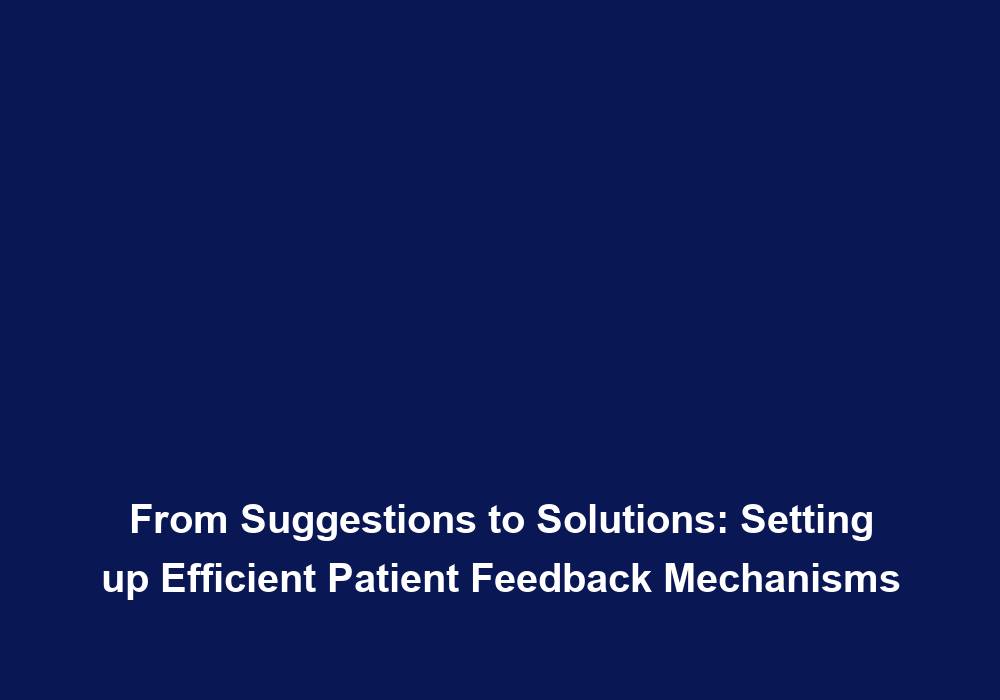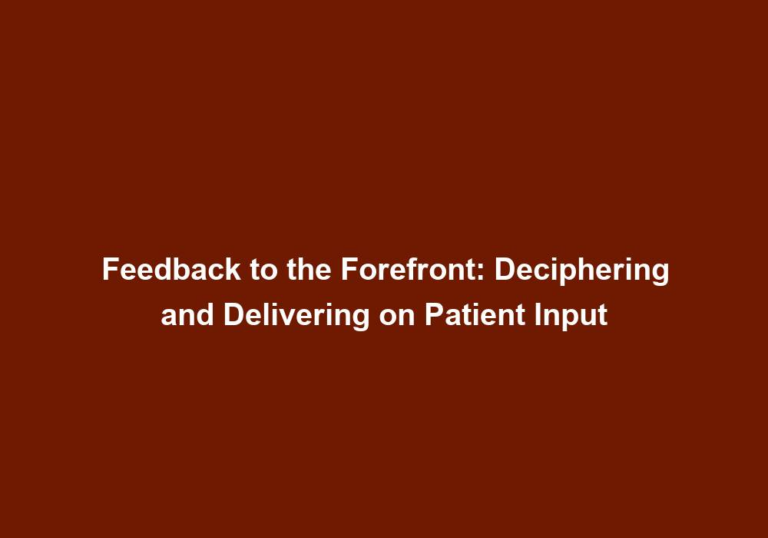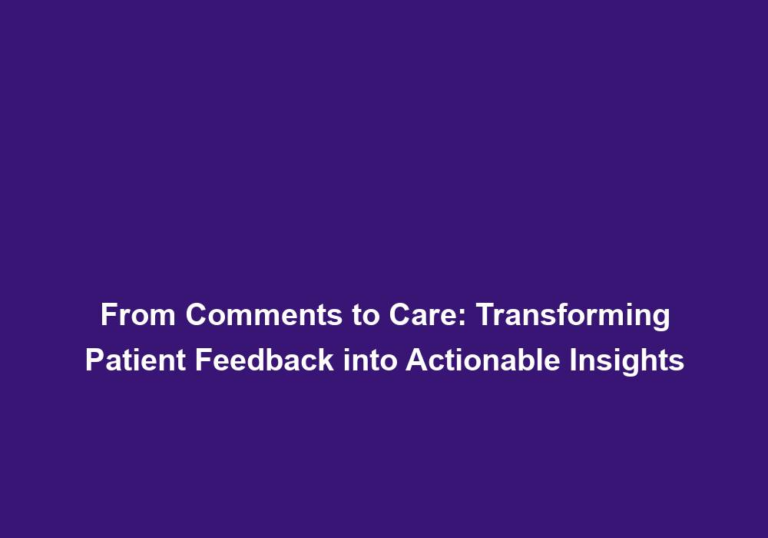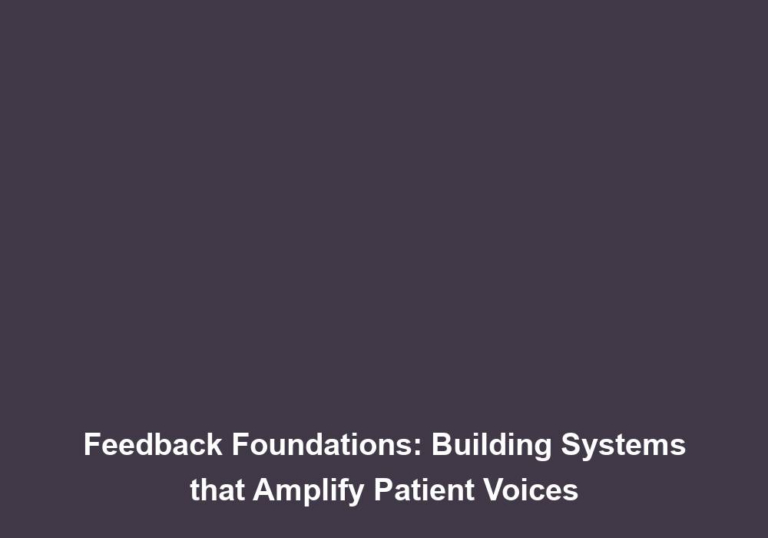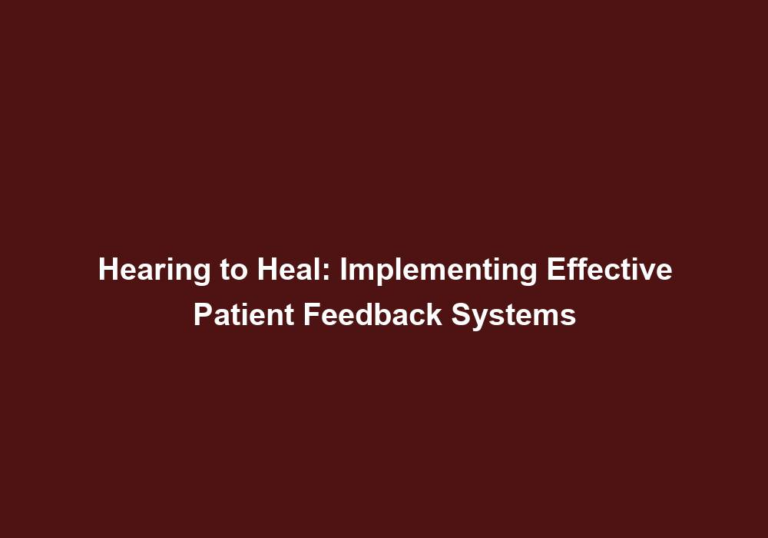From Suggestions to Solutions: Setting up Efficient Patient Feedback Mechanisms
In today’s fast-paced healthcare industry, it is crucial for healthcare organizations to establish efficient patient feedback mechanisms. By effectively collecting, analyzing, and acting upon patient feedback, healthcare providers can improve the quality of care, enhance patient satisfaction, and drive organizational growth. In this article, we will explore the key strategies and best practices for setting up robust patient feedback mechanisms.
Why Patient Feedback Matters
Patient feedback is a valuable source of information that enables healthcare providers to understand the needs, expectations, and experiences of their patients. By actively seeking and addressing patient feedback, healthcare organizations can:
- Improve Quality of Care: Patient feedback allows healthcare providers to identify areas of improvement and implement measures to enhance the quality of care they deliver. By understanding patient perspectives, healthcare organizations can refine existing processes, workflows, and policies to better meet patient needs.
-
Collecting patient feedback helps healthcare providers identify gaps in the quality of care they provide. By analyzing the feedback, healthcare organizations can identify specific areas where improvements can be made, such as reducing wait times, improving communication between healthcare professionals and patients, or enhancing the overall patient experience.
-
Patient feedback can uncover issues that may otherwise go unnoticed. Through feedback, healthcare providers can identify patterns or recurring issues, allowing them to address underlying problems and make necessary changes to improve the quality of care.
-
Addressing patient feedback can lead to better patient outcomes. By taking action based on feedback, healthcare organizations can implement changes that positively impact patient health and well-being. This can include improvements in treatment protocols, medication management, or follow-up care.
- Enhance Patient Satisfaction: By actively listening to patient feedback, healthcare providers can identify pain points and address them promptly. This leads to improved patient satisfaction and a positive patient experience. Satisfied patients are more likely to recommend the healthcare organization to others, contributing to its reputation and growth.
-
Patient feedback provides valuable insights into areas where patients may be dissatisfied. By addressing these concerns, healthcare organizations can improve patient satisfaction and loyalty. This can include addressing issues related to communication, accessibility, or the overall care experience.
-
Promptly addressing patient feedback shows that healthcare providers value patient opinions and are committed to delivering high-quality care. This can help foster a positive patient-provider relationship and build trust between patients and healthcare organizations.
-
Enhancing patient satisfaction through feedback can lead to increased patient retention and loyalty. Satisfied patients are more likely to continue seeking care from the same healthcare organization and recommend it to others, resulting in increased growth and success.
- Drive Continuous Improvement: Patient feedback serves as a catalyst for continuous improvement. Regularly collecting and analyzing patient feedback allows healthcare organizations to identify trends, patterns, and recurring issues. By addressing these concerns, healthcare providers can drive positive change, improve patient outcomes, and optimize their operations.
-
Patient feedback provides valuable data that can be used to identify opportunities for improvement. By analyzing feedback, healthcare organizations can identify areas where processes can be streamlined, resources can be better allocated, or training can be provided to healthcare professionals.
-
Acting upon patient feedback demonstrates a commitment to continuous improvement. By actively seeking feedback and making changes based on that feedback, healthcare organizations show a dedication to providing the best possible care and continuously evolving to meet patient needs.
-
Continuous improvement driven by patient feedback can lead to better overall healthcare outcomes. By addressing patient concerns and making necessary changes, healthcare organizations can optimize their operations and deliver more effective and efficient care to patients.
Setting up Effective Patient Feedback Mechanisms
To establish efficient patient feedback mechanisms, healthcare organizations must consider the following strategies and best practices:
1. Clearly Define Objectives and Goals
Before implementing any patient feedback mechanisms, it is important to clearly define the objectives and goals. Determine what specific outcomes the organization aims to achieve through patient feedback, such as improving patient satisfaction or streamlining processes. By establishing clear goals, healthcare providers can align their efforts and measure the success of their feedback mechanisms.
-
Clearly defined objectives provide a roadmap for healthcare organizations to follow when implementing patient feedback mechanisms. This helps ensure that efforts are focused and targeted towards achieving specific outcomes.
-
Setting goals allows healthcare providers to measure the effectiveness of their feedback mechanisms. By establishing key performance indicators (KPIs) and regularly evaluating progress, organizations can track their success and make adjustments as needed.
-
Clearly defined objectives and goals also help communicate the importance of patient feedback to staff and stakeholders. When everyone understands the purpose and desired outcomes, they can work together towards achieving them.
2. Choose the Right Feedback Channels
There are several channels through which healthcare organizations can collect patient feedback, including surveys, suggestion boxes, online platforms, and social media. It is essential to choose the right channels based on the target audience and their preferences. Utilizing multiple channels allows for a wider reach and a more comprehensive understanding of patient experiences.
-
Different patients may have different preferences when it comes to providing feedback. By offering multiple channels, healthcare organizations can accommodate various communication preferences and ensure that all patients have an opportunity to provide their feedback.
-
Choosing the right feedback channels helps ensure that the feedback received is relevant and accurate. It is important to select channels that are easily accessible to patients and align with their communication habits.
-
Utilizing multiple feedback channels provides a more comprehensive view of patient experiences. By collecting feedback from various sources, healthcare organizations can gather a wider range of perspectives and identify common themes or issues.
3. Develop Comprehensive Surveys
Surveys are a popular and effective way to gather patient feedback. When developing surveys, it is important to craft questions that are clear, concise, and unbiased. Include a mix of closed-ended and open-ended questions to capture both quantitative and qualitative feedback. Consider utilizing standardized survey instruments, such as the Net Promoter Score (NPS), to benchmark and compare results over time.
-
Clear and concise survey questions help ensure that patients understand what is being asked and can provide accurate responses. It is important to use language that is easy to understand and avoid jargon or technical terms.
-
Including a mix of closed-ended and open-ended questions allows for a more comprehensive understanding of patient experiences. Closed-ended questions provide quantitative data that can be easily analyzed, while open-ended questions offer valuable qualitative insights.
-
Utilizing standardized survey instruments, such as the Net Promoter Score (NPS), provides a benchmark for comparison and allows healthcare organizations to track changes in patient feedback over time. This can help identify trends and areas for improvement.
4. Encourage Anonymous Feedback
To ensure honest and unbiased feedback, healthcare organizations should provide patients with the option to submit feedback anonymously. This allows patients to freely express their thoughts and concerns without fear of retribution. Anonymity can be facilitated through online platforms or anonymous suggestion boxes placed in strategic locations.
-
Anonymity encourages patients to provide honest feedback without the fear of negative consequences. This can lead to more genuine and accurate feedback that reflects patients’ true experiences and opinions.
-
Providing multiple options for anonymous feedback allows patients to choose the method that is most comfortable for them. Some patients may prefer the anonymity of online platforms, while others may feel more comfortable using suggestion boxes in person.
-
Anonymity also helps protect patient privacy and confidentiality. By ensuring that feedback is submitted anonymously, healthcare organizations can maintain patient trust and adhere to privacy regulations.
5. Actively Listen and Respond
Collecting patient feedback is only the first step; it is equally important to actively listen and respond to it. Establish a dedicated team or individual responsible for reviewing and addressing patient feedback in a timely manner. Acknowledge receipt of feedback and communicate the actions taken to address any issues raised. This demonstrates to patients that their feedback is valued and encourages them to continue providing input.
-
Actively listening to patient feedback shows that healthcare organizations value patient opinions and are committed to improving their services. This can help build trust and strengthen the patient-provider relationship.
-
Establishing a dedicated team or individual responsible for reviewing and addressing feedback ensures that feedback is not overlooked or ignored. This helps create a culture of accountability and responsiveness within the organization.
-
Communicating the actions taken in response to patient feedback helps close the feedback loop and provides transparency. Patients appreciate knowing that their feedback has been heard and that changes are being made based on their input.
6. Implement Continuous Monitoring
Patient feedback should be collected on an ongoing basis to enable continuous monitoring and improvement. Set up systems to review and analyze feedback regularly, identifying trends and patterns. Use this information to inform decision-making, prioritize areas for improvement, and track progress over time. Regularly communicating the impact of patient feedback-driven initiatives to staff fosters a culture of accountability and continuous improvement.
-
Continuous monitoring of patient feedback helps healthcare organizations stay informed about changing patient needs and expectations. By regularly reviewing and analyzing feedback, organizations can identify emerging trends or issues that require attention.
-
Identifying trends and patterns in patient feedback allows healthcare organizations to make data-driven decisions. By understanding the common themes or issues raised by patients, organizations can prioritize areas for improvement and allocate resources accordingly.
-
Regular communication with staff about the impact of patient feedback-driven initiatives fosters a culture of accountability and continuous improvement. When staff are aware of the changes being made based on patient feedback, they are more likely to be engaged and actively contribute to the improvement efforts.
7. Share Feedback Results
Transparency is key when it comes to patient feedback. Share feedback results and relevant insights with staff, ensuring that they are aware of patient perspectives. This encourages a patient-centric approach and fosters a sense of ownership among healthcare professionals. Sharing feedback results can also inspire staff to innovate and develop solutions that address patient concerns.
-
Sharing feedback results with staff helps create a patient-centric culture within the organization. When healthcare professionals are aware of patient perspectives, they are more likely to prioritize patient needs and deliver care that aligns with patient expectations.
-
By sharing feedback results, healthcare organizations demonstrate a commitment to transparency and accountability. This fosters trust among staff and patients alike, as they can see that feedback is being taken seriously and used to drive positive change.
-
Feedback results can serve as inspiration for staff to innovate and develop solutions that address patient concerns. By sharing success stories or examples of how feedback has led to improvements, healthcare organizations can encourage staff to actively participate in the feedback process and contribute their ideas.
8. Seek Patient Engagement
Actively involve patients in the feedback process by seeking their input on improvement initiatives. Establish patient advisory groups or hold focus groups to gather insights from patients representing diverse demographics and experiences. By involving patients in decision-making processes, healthcare organizations can gain valuable perspectives and ensure that patient feedback is truly integrated into their operations.
-
Patient engagement in the feedback process ensures that their voices are heard and their needs are taken into account. By actively seeking patient input, healthcare organizations can make more informed decisions and improve the relevance and effectiveness of their services.
-
Establishing patient advisory groups or holding focus groups allows for in-depth discussions and a deeper understanding of patient experiences. This can uncover valuable insights and perspectives that may have otherwise been overlooked.
-
Involving patients in decision-making processes empowers them and helps create a patient-centered approach to care. When patients have a say in the improvements being made, they are more likely to feel valued and satisfied with the care they receive.
Conclusion
Setting up efficient patient feedback mechanisms is crucial for healthcare organizations seeking to enhance the quality of care, improve patient satisfaction, and drive continuous improvement. By clearly defining objectives, choosing the right feedback channels, and actively listening to patient feedback, healthcare providers can transform patient suggestions into actionable solutions. Embracing a patient-centric culture and involving patients throughout the feedback process will contribute to the overall success of these mechanisms and ultimately result in improved healthcare outcomes.

